Social DNA

Реклама. ООО «ЛитРес», ИНН: 7719571260.
Оглавление
M. Kay Martin. Social DNA
SOCIAL DNA
Contents
Illustrations
Preface
Introduction. SOME GIVENS
Genes, Epigenesis, and Social DNA
Chronologies, Crania, and Traditions
Water Drives Ecology
Ecology Drives Social Forms
False Prototypes
Aggress or Coalesce?
Science and Storytelling
Humans as Chameleons
1. PERSPECTIVES ON ANISOGAMY
Size Matters
Perception of Conception
Reproductive Roles and Social Origins Theory
Exploitation and Parasitism
Complementarity and Cooperation
2. FIRST FAMILIES
Framing the Primeval Family
Plio-Pleistocene Paleoenvironment
Natures and Reproductive Strategies of the Sexes
Pair Bonding, Paternity, and Provisioning
Analogs and Avatars
Ancestral Male Kin Group Hypotheses
Primeval Environment and Subsistence
Sexuality, Mating, and Fitness
Philopatry and Social Structure
Primate Avatars and Analogs
Shortcomings of Androcentric Models
Pliocene Ecology Revisited
Gender Stereotyping and Fitness
Philopatry and Human Trait Complexes
Selective Prototypes
Ecology and Female Choice
Female Foraging and the Matricentric Family
Cooperative Breeding and Eusociality
Anisogamy and Inclusive Fitness Revisited
Multilevel Selection Revisited
Solving Galton’s Problem
3. PALEOECOLOGY AND EMERGENCE OF GENUS HOMO
Romance of the Hunt
Climate Change, Water, and Ecology
Don’t Go Near the Water
Semi-Aquatic Habitats, Resources, and Dietary Lipids
An Alternative Plio-Pleistocene Scenario
Female Subsistence Strategies
Female Reproductive Strategies
Encephalization and Energetics
4. PALEOLITHIC DINNER PAIRINGS. Red or White?
The Two Faces of Carnivory
The Question of Dietary Breadth
Labor Division, Productivity, and Complexity
Toward More Inclusive Models
5. SIGNATURE HOMININ TRAITS
Opportunistic Omnivory
Spatiotemporal Roadmapping
Polygynandrous Mating
Behavioral Plasticity
Encephalization and Intelligence
Pleistocene Material Remains
Neocortex Size and the Social Brain
Mosaic Brain Evolution
Social Demography
Energetics and Labor Division
6. KINSHIP AND PALEOLITHIC LEGENDS
Universal Evolutionary Stages
Kinship Theory and Politics
Innate Male Dominance
The Human Biogram
Pan-Genesis Theory
Genomic Imprinting, Kinship, and Inclusive Fitness
Conclusion
7. KINSHIP AS SOCIAL TECHNOLOGY
The Essence of Kinship
Conditions Favoring Matrilineal Organization
Subsistence and Labor Contributions
Warfare, Migration, and Matrilocality
Demographics, Resources, and Labor Supply
The Matrilineal Puzzle
The Vanishing Matrilineal Niche
Conditions Favoring Patrilineal Organization
Kinship and Subsistence Dominance
Demographics, Resources, and Fitness
Scarcity, Wealth, and Productivity
Conditions Favoring Bilateral Organization
Bilaterality as Primeval
Bilaterality as Devolved Uniliny
Kinship in Evolutionary Perspective
Epilogue
Endnotes. Introduction. Some Givens
Chapter 1. Perspectives on Anisogamy
Chapter 2. First Families
Chapter 3. Paleoecology and Emergence of Genus Homo
Chapter 4. Paleolithic Dinner Pairings: Red or White?
Chapter 5. Signature Hominin Traits
Chapter 6. Kinship and Paleolithic Legends
Chapter 7. Kinship as Social Technology
Bibliography
Index
Отрывок из книги
SOCIAL DNA
M. Kay Martin
.....
A major criticism of the one-species theory lies in the degree of diversity observed in the accumulating hominin fossil record. A wide variety of hominins appear to have lived contemporaneously throughout the Pleistocene, alternating periods of migration and inbreeding with periods of relative isolation and genetic bottlenecks. Paleontologists disagree on where to draw species boundaries among disparate lineages of ancient hominins, but are increasingly reticent to view the course of human evolution as a linear progression of forms—as a single main line flanked by a number of side branches or dead ends. Rather, our evolutionary pathway may more closely approximate a braided stream, the various branches of which periodically diverged, crossed over, and reconnected throughout the Pleistocene.
Boaz and Ciochon (2004: 166) have suggested that it may be more appropriate to replace the concept of gene pool with gene sea, across which genes flowed subject to the currents, waves, and eddies created by climate change and natural selection. Adaptive changes have taken place gradually among closely related populations, creating clinal gradients over time and space. Homo sapiens is now, and has always been, a polytypic species. The recent sequencing of Neanderthal and modern human DNA lends credence to the notion of ancient gene exchange and of population replacement through hybridization. Resources and opportunities permitting, Pleistocene hominins made love, not war. The braided stream model of gene flow and speciation will be favored in this book.
.....